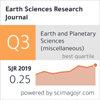库纳斯祖母绿矿的矿物学和流体包裹体,Maripí, boyac,哥伦比亚
IF 0.5
4区 地球科学
Q4 GEOSCIENCES, MULTIDISCIPLINARY
引用次数: 2
摘要
库纳斯矿目前是哥伦比亚优质祖母绿的主要产地之一;它的祖母绿典型地显示出壮丽的绿色色调,在世界市场上受到高度赞赏。成矿见于Muzo组富钒黑色页岩;祖母绿产于热液脉和角砾岩中,主要由方解石、白云石、钠长石、石英和少量黄铁矿、parisite-(Ce)和萤石组成;热液蚀变普遍,以钠长石化和碳酸化为主。含祖母绿的流体包裹体非常丰富,非常大而复杂。多相包裹体普遍存在于祖母绿和脉石矿物中,由两个子晶体组成(典型的是卤石和方解石或菱铁矿;特别是parisite-(Ce)),一种液态盐水,一种富含CO2- n2 - ch4的气泡,偶尔也有少量的液态CO2。石英中发现富气包裹体,方解石和白云石中发现两相包裹体,表明流体演化过程复杂。显微测温分析表明,形成祖母绿的流体在相对较低的温度≈260 ~ 340℃,压力≈875 ~ 2400 kbar下被捕获,密度相对较高,为- 1.03 g/cm³-,盐度升高39% NaCl eq. Wt;检测到的其他水溶液组分包括CaCl2、KCl和FeCl2。根据这些资料,我们认为库纳斯矿的祖母绿成矿是由两种不同来源的热液混合形成的;一种由蒸发岩溶解产生的高盐度流体,对寄主岩石的钠长石化起作用;二是由原生水演化而来的富钙流体,通过与含钙质和富有机质的围岩相互作用达到平衡。结果表明,祖母绿成矿发生在有利于流体混合的构造部位。所描述的库纳斯矿的地质和物理化学特征与由相对低温的非岩浆流体的循环和混合形成的哥伦比亚型表生沉积成矿相一致。本文章由计算机程序翻译,如有差异,请以英文原文为准。
Mineralogy and Fluid Inclusions of the Cunas Emerald Mine, Maripí, Boyacá, Colombia
The Cunas mine is currently one of the major producers of fine emeralds in Colombia; its emeralds typically display a magnificent green hue, which is highly appreciated in the world market. The mineralization is found in vanadium-rich black shales of the Muzo formation; emeralds occur in pockets within hydrothermal veins and breccias, consisting mostly of calcite, dolomite, albite, quartz, and minor pyrite, parisite-(Ce), and fluorite; hydrothermal alteration is pervasive and dominated by albitization and carbonatization. Emerald-hosted fluid inclusions are highly abundant and remarkably large and complex. Poly-phase inclusions are ubiquitous, occur both in emeralds and gangue minerals, and consist of two daughter crystals (typically halite and calcite or siderite; exceptionally parisite-(Ce)), a liquid brine, a CO2-N2-CH4-rich gas bubble, and occasionally minor liquid CO2. Vapor-rich inclusions were observed in quartz, and two-phase inclusions were identified in calcite and dolomite, thus suggesting a complex fluid evolution. Microthermometry analysis indicates the emerald-forming fluids were trapped at relatively low temperature ≈ 260-340°C and pressure ≈ 875-2400 kbar, with relatively high density —1.03 g/cm³—, and elevated salinity 39% NaCl eq. Wt.; other aqueous components detected include CaCl2, KCl, and FeCl2. Based on these data, we propose the emerald mineralization at the Cunas mine was originated by the mixing of two hydrothermal fluids of different sources; one fluid with high salinity derived from evaporite dissolution, responsible for the albitization of the host rocks; the second is a calcium-rich fluid evolved from connate waters, which was equilibrated by the interaction with calcareous and organic-rich wall rocks. As a result, emerald mineralization took place at structurally favorable sites where fluid mixing was promoted. The described geological and physicochemical features for the Cunas mine, are in agreement with an epigenetic sediment-hosted mineralization —Colombian-type— formed by the circulation and mixing of relatively low-temperature non-magmatic fluids.
求助全文
通过发布文献求助,成功后即可免费获取论文全文。
去求助
来源期刊

Earth Sciences Research Journal
地学-地球科学综合
CiteScore
1.50
自引率
0.00%
发文量
0
审稿时长
>12 weeks
期刊介绍:
ESRJ publishes the results from technical and scientific research on various disciplines of Earth Sciences and its interactions with several engineering applications.
Works will only be considered if not previously published anywhere else. Manuscripts must contain information derived from scientific research projects or technical developments. The ideas expressed by publishing in ESRJ are the sole responsibility of the authors.
We gladly consider manuscripts in the following subject areas:
-Geophysics: Seismology, Seismic Prospecting, Gravimetric, Magnetic and Electrical methods.
-Geology: Volcanology, Tectonics, Neotectonics, Geomorphology, Geochemistry, Geothermal Energy, ---Glaciology, Ore Geology, Environmental Geology, Geological Hazards.
-Geodesy: Geodynamics, GPS measurements applied to geological and geophysical problems.
-Basic Sciences and Computer Science applied to Geology and Geophysics.
-Meteorology and Atmospheric Sciences.
-Oceanography.
-Planetary Sciences.
-Engineering: Earthquake Engineering and Seismology Engineering, Geological Engineering, Geotechnics.
 求助内容:
求助内容: 应助结果提醒方式:
应助结果提醒方式:


